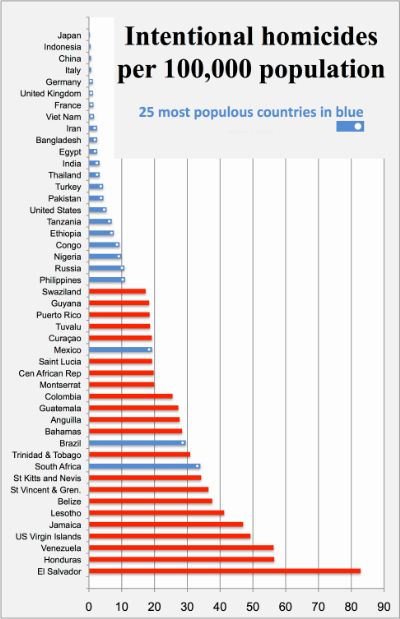A report issued by the United Nations Office on Drug and Crime in July 2019 documented that nearly 464,000 people around the world were killed in homicides in 2017, a number significantly in excess of the 89,000 killed in armed conflicts and terrorism combined during the same period. Globally, 0.7% deaths in 2019 were the result of homicide.

Homicide has become a leading cause of death in developed countries. Between 1976 and 1993, more of Americans were murdered in their native land than died on the battlefields of World War II.
USA and developed countries
Homicide is currently the second leading cause of death among Americans 15 to 24 years of age, and the third leading cause among children 5 to 14. In 1943 there were exactly 44 homicides by gunshot in all of the city of New York, whereas in 1992 there were 1,499.
The new data show the US homicide rate increased from about six homicides per 100,000 people in 2019 to 7.8 per 100,000 in 2020, according to NCHS. Researchers at the center noted that the 2020 homicide rate of 7.8 is the highest recorded in the United States since 1995 but is still significantly lower than the rates in the early 1980s, which topped 10 homicides per 100,000 people.
While the initial release of the NCHS preliminary data did not provide a total number of homicides from 2020, the FBI’s Uniform Crime Report recorded about 21,570 murders total last year – compared with an estimated 16,425 murders in 2019.
The differences between proximate countries are intriguing: rates are 40 percent higher for Australians than for New Zealanders, 50 percent higher for Italians than for Swiss, three times greater in Norway than in Finland, and four times greater in the U.S. than in Canada. But with the merging of economies and the US-driven mass culture spread-out, differences tend to disappear.

The superiority of the US in terms of victims can be explained by several factors such as the American culture of violence, a legacy of relatively advanced civilizations encountering and conquering the frontier. Gun control is still very loosy and most popular series and blockbusters produced by Hollywood are filled with violence, crimes and deaths. The relatively high degree of cultural and racial heterogeneity added to economic inequalities between and within the races lead to extent of social disorganization and increase in crimes.
Rest of the World
Across most of Western Europe, for example, less than 0.1% of deaths were the result of homicide. Across much of Eastern Europe, North Africa, Asia and Oceania, it was less than 0.5%. In the United States it was 0.7%.
But in some countries the share is much higher. We see particularly high rates across some countries in Latin America. More than 7% of deaths in El Salvador were from homicide; more than 6% in Guatemala; and 5% in Venezuela.
In some countries homicide is one of the largest killers. Homicide rates across some countries in Latin America are particularly high– in particular, El Salvador, Venezuela, Honduras, Guatemala, and Mexico. Rates here are often greater than 30 deaths per 100,000 – in El Salvador this was over 45 per 100,000. In 2017, homicide was the third largest cause of death in Venezuela; fourth in Honduras; and fifth in Guatemala. In Latin America homicides are the leading cause of death in 15 to 49 year olds. Twice as many young adults die from homicide as from road accidents. In Honduras, it’s four times as many.
Legal definition
Criminal homicide takes many forms including accidental killing or murder. Criminal homicide is divided into two broad categories, murder and manslaughter, based upon the state of mind and intent of the person who commits the homicide.
Murder is typically broken down further into several sub-categories. The most common are first and second degree murder.
First degree murder is the most serious of all homicide charges. It applies to situations in which someone is accused of killing another person after having planned to kill the victim. It requires malice (evil intent) and forethought (planning). These cases are usually considered among the most heinous crimes and as such, the most severe punishments are usually reserved for these convictions, including life in prison or the death penalty.
Second degree murder, on the other hand, usually applies to cases in which someone may have intended to kill another, but did not have time to plan it (a crime of passion). For example, a husband that flies into a rage and kills his wife when he comes home to discover her in bed with another man could be a second degree murder. Some states also apply the label of second degree murder to situations in which someone’s actions were so wanton and reckless that the death of another person was readily foreseeable, even if killing someone was not the intention, such as driving at speed into a crowd of people. Second degree murder is also very serious, and in most situations the defendant will face life in prison or a similarly harsh sentence, though the death sentence is not an option.
Manslaughter, the charge of manslaughter is reserved for instances where the accused did not plan the crime nor did he or she intend for the victim to die because of his or her actions. Manslaughter charges usually arise out of accidental circumstances where a person died because of the event. For example, a doctor who prescribes drugs that can have a lethal interaction for a patient, a parent that leaves a baby in a hot car, or a driver who causes a fatal car accident. Sentences for those convicted of manslaughter vary widely depending on state laws and the circumstances of the event in question, but are usually somewhat less than second degree murder.
Lawful excuse
Not all homicides are crimes, or subject to criminal prosecution. Some are legally privileged, meaning that they are not criminal acts at all. Others may occur under circumstances that provide the defendant with a full or partial defense to criminal prosecution.
- Self-defense: while most homicides by civilians are criminally prosecutable, a right of self-defense (often including the right to defend others)is widely recognized, including, in dire circumstances, the use of deadly force.
- Mental incapacity: A defendant may attempt to prove that they are not criminally responsible for a homicide due to a mental disorder. In some jurisdictions, mentally incompetent killers may be involuntarily committed in lieu of criminal trial. Mental health and development are often taken into account during sentencing. For example, in the United States, the death penalty cannot be applied to convicted murderers with intellectual disabilities.
- Defense of infancy – Small children are not held criminally liable before the age of criminal responsibility. A juvenile court may handle defendants above this age but below the legal age of majority, though because homicide is a serious crime some older minors are charged in an adult justice system. Age is sometimes also taken into account during sentencing even if the perpetrator is old enough to have criminal responsibility.
- Justifiable homicide or privilege: Due to the circumstances, although a homicide occurs, the act of killing is not unlawful. For example, a killing on the battlefield during war is normally lawful, or a police officer may shoot a dangerous suspect in order to protect the officer’s own life or the lives and safety of others.
Other Homicides
Some states have developed other forms of homicide crimes. For example, one modern trend is the felony murder charge. In felony murder, a person has died while the defendant was participating in the commission of a crime, but the defendant did not actually cause the death. For example, if several people storm into a convenience store for an armed robbery and one of them shoots the cashier, killing him, the other two can be charged with felony murder even though they did not actually kill anyone. States’ laws are constantly evolving and diverging, so other forms of homicide may exist or may come into existence in the future.
As noted, homicide is always serious. If you or someone you know has been involved with a homicide contact an attorney for assistance in dealing with this matter as soon as possible. This article is no alternative to competent legal counsel.
Type of homicides
Poisoning
Presenting symptoms and signs are often misdiagnosed as natural disease, especially if the crime is committed in a hospital environment, suggesting that an unknown number of homicides go undetected.In the reported cases analyzed, the lethal agent of choice has changed over the years. In earlier years, traditional poisons such as arsenic, cyanide, and parathion were frequently used. Such poisonings are nowadays rare, and instead, narcotics are more commonly detected in victims of this crime.
Blugeoning with a blunt instrument.
Only likely to be fatal if is on the head. Death is usually from skull fracture pushing fragments of bone into the brain, or internal bleeding between the skull and the dura – the membrane covering the brain.
Burning
usually kills by asphyxia from smoke inhalation. Bodies exposed to intense heat are stiffened, posed like a boxer ready to fight. As burning is sometimes used to cover up other crimes the presence of burns on the body needn’t imply that this was the cause of death.
Drowning
kills by asphyxia, as the lungs fill with liquid. Post-mortem signs:
Embolism
clogging of the blood vessels with air, or sometimes fat. This blocks blood supply to the heart or brain. A fat embolism is rare but can happen when burning or other injury releases fat particles into the blood.
Explosives
kills in a variety of ways: flash burns, disintergration of body, effects of air pressure. Also by the results of the explosion – flying glass, collapsing buildings etc
Gunshot and knife wounds
Mortal when a major organ is touched or blood is not stopped after an arteri is cut.
Suicide and homicide can normally be distinguished by the direction of the thrust. Also, suicides normally take the clothing off the part of the body there are going to stab.
Strangulation
by hand, a ligature, or hanging. Death is by asphyxia. Homicidal strangulation will almost always fracture the hyiod bone. Manual strangulation tends to leave finger-shaped bruises and sometimes nail marks in the skin.
Suffocation
- Suffocation: If there isn’t enough oxygen in the air, such as when trapped in a small space
- Smothering: Caused by an object over the mouth and nose, such as a pillow or the murderer’s hand.
- Choking: Caused by an obstruction in the airway – food, inhaled vomit etc Seldom used in homicide, except when people choke on their gags.
- Crush asphyxia: Caused by pressure on the chest, such as a collapsed building, or in a crowd. Post-mortem appearances include a lot of hemorrhaging between the chest and head, cyanosis, bulging eyes etc








